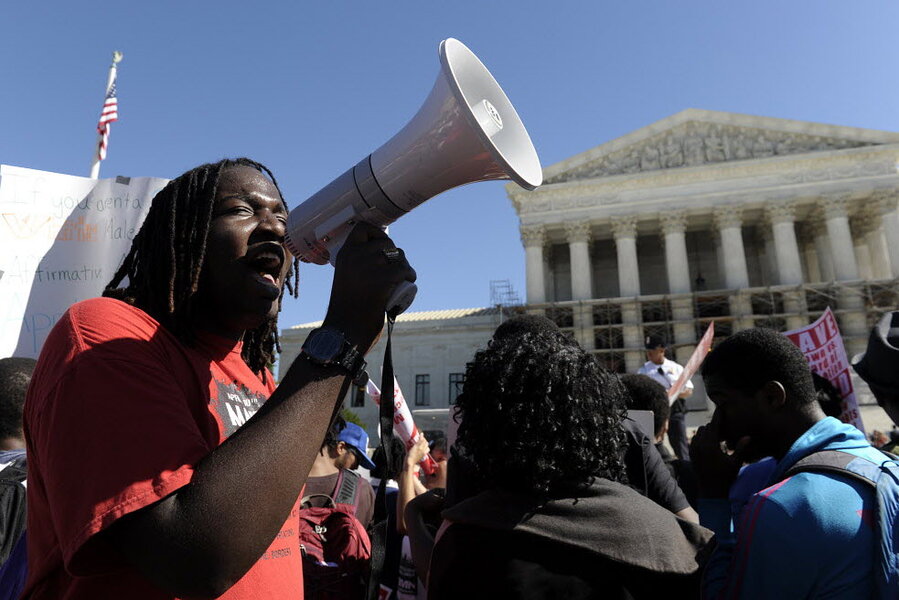Groups react to Supreme Court decision upholding ban on race-based admissions
Loading...
| Washington
Reaction to the US Supreme Court decision on Tuesday upholding a Michigan constitutional ban on race-conscious affirmative action programs was as divided and heated as the underlying debate over racial preferences in college admissions.
Those who opposed the use of racial preferences praised the court’s decision, while supporters of using affirmative action to boost racial and ethnic diversity on in college classes expressed disappointment.
“This case was about the democratic process and whether voters can rein in the powers of their state government,” said Ilya Shapiro of the Cato Institute.
“The answer to that question, like the answer to the question of whether the Equal Protection Clause mandates racial preferences, is self-evident,” he said in a statement.
Affirmative action supporters said it would now be more difficult for public universities in Michigan to build more diverse student populations.
“In a democracy, everyone should have equal access to the political process. The Court’s decision takes our nation’s commitment to equal treatment under the law a step backward,” Wade Henderson, president of the Leadership Conference on Civil and Human Rights, said in a statement.
“This case is ultimately about whether students of color in Michigan are allowed to compete on the same playing field as all other students. Today, the Supreme Court said they are not,” said Mark Rosenbaum, a lawyer with the American Civil Liberties Union who argued the case at the high court to overturn the Michigan ban.
“Proposal 2 unfairly keeps students from asking universities to consider race as one factor in admissions, but allows consideration of factors like legacy status, athletic achievement, and geography,” Mr. Rosenbaum said in a statement.
The case, argued in October, involved a challenge to a statewide referendum, Proposal 2, that amended the Michigan constitution. By a 58 percent majority, voters barred state officials, including officials at state universities, from discriminating against, or granting preferential treatment to, anyone on the basis of race, ethnicity, color, sex, or national origin.
Affirmative action supporters filed a lawsuit in federal court seeking to block enforcement of the statewide ban. A federal judge upheld the amendment, but a sharply divided Sixth US Circuit Court of Appeals struck down the measure.
The appeals court said the ban on racial discrimination and racial preferences violated the Constitution’s Equal Protection Clause by changing the political process in a way that made it more difficult for minority groups to obtain race-based preferences in college admissions.
The court said that before the statewide ban, minority groups could lobby members of each university’s board of trustees to enact or expand affirmative action plans. Now, with the ban, those efforts are blocked. The only avenue left for minority groups favoring affirmative action is to mount their own referendum campaign to repeal the ban.
That burden, the appeals court said, was too high and violated the Constitution’s Equal Protection Clause.
In rejecting that decision, the high court said that state voters are entitled to determine issues of public policy by majority vote. Writing for the court, Justice Anthony Kennedy rejected suggestions that the ban stacks the political cards against minority groups.
“It is demeaning to the democratic process to presume that the voters are not capable of deciding an issue of this sensitivity on decent and rational grounds,” Justice Kennedy wrote.
“Voters can decide they don’t want racial double standards in university admissions. That is the essence of the Supreme Court’s 6 to 2 decision,” said Abigail and Stephen Thernstrom, longtime affirmative action critics, in a statement.
They said the decision was not a surprise, but was, nevertheless “very welcome.”
Curt Levey, president of the Committee for Justice, said the decision was an important victory for equality. “The Supreme Court rejected the far-fetched argument that requiring equal treatment regardless of race, as the voters of Michigan did, is a violation of the Constitution’s guarantee of equal protection,” Mr. Levey said in a statement.
“Today’s decision is an affirmation of Supreme Court precedent that barely permits racial preferences in limited circumstances and has never required preferences be used in the name of diversity,” he said.
Others saw the ruling as a major setback.
“Today’s decision turns back our nation’s commitment to racial equality and equal treatment under the law by sanctioning separate and unequal political processes that put undue burdens on students,” National Education Association President Dennis Van Roekel said in a statement.
“The Supreme Court has made it harder to advocate and, ultimately, achieve equal educational opportunity,” Roekel said.
Others said the decision would open doors for a wider application of equal treatment.
“Today, the Supreme Court moved us close to the colorblind principle that Martin Luther King advocated and that is embedded in the 14th Amendment,” said Horace Cooper, co-chair of Project 21, an organization of black conservatives.
“I’m pleased that the principle of treating all Americans the same under the law can go forward in Michigan,” Mr. Cooper said in a statement.







